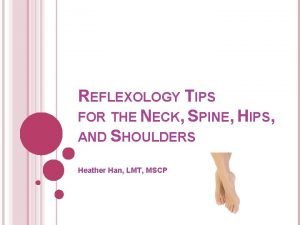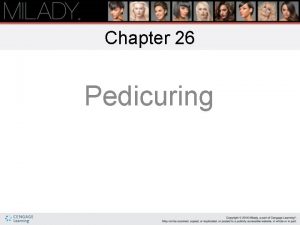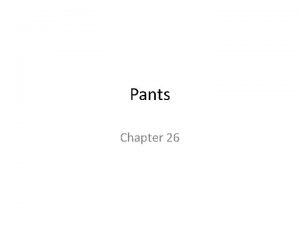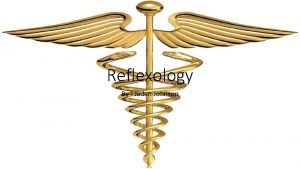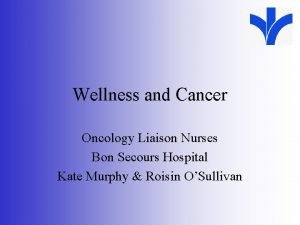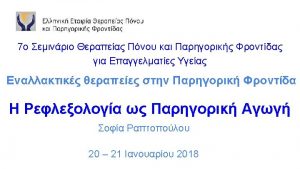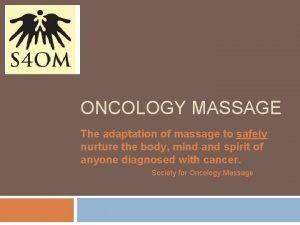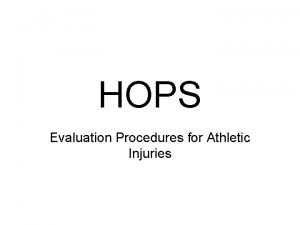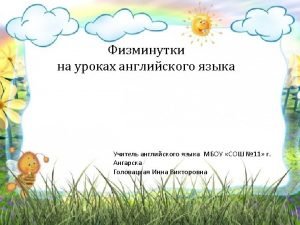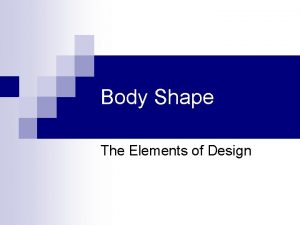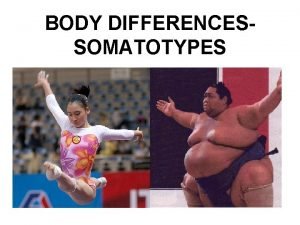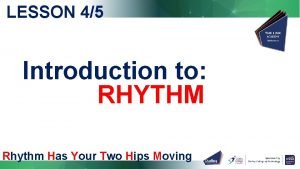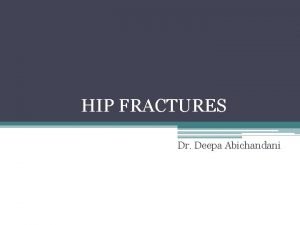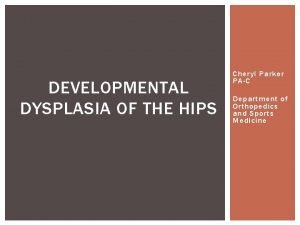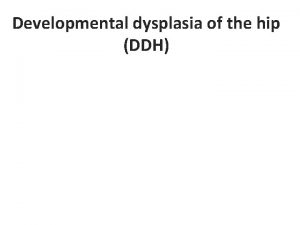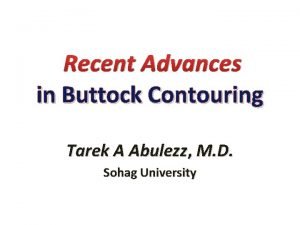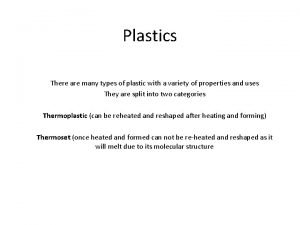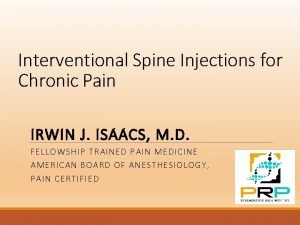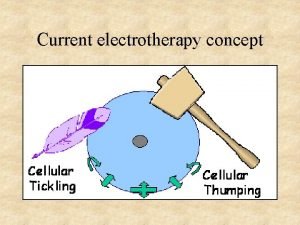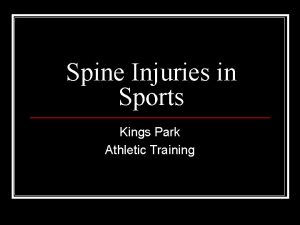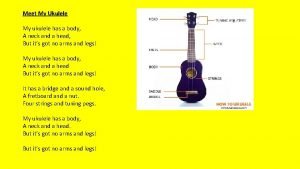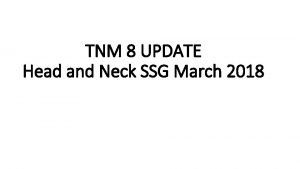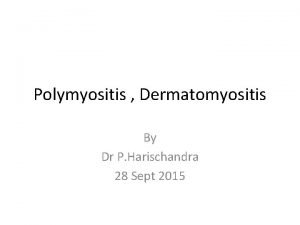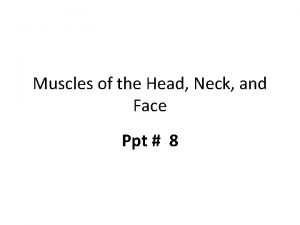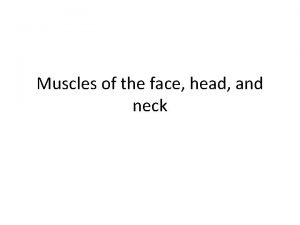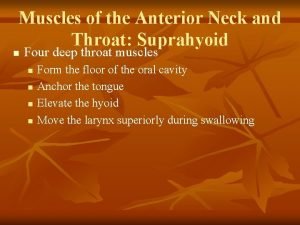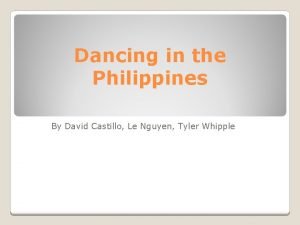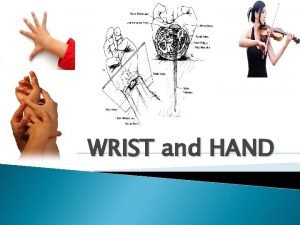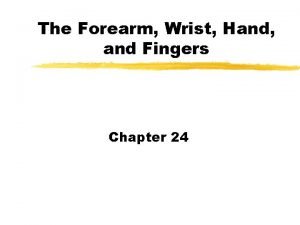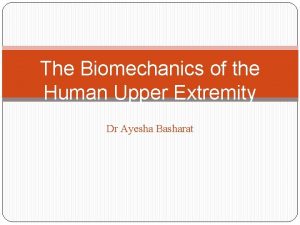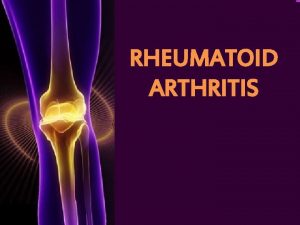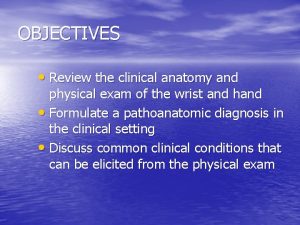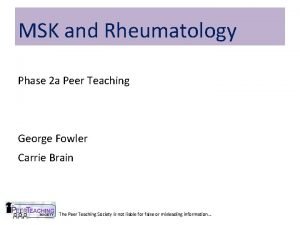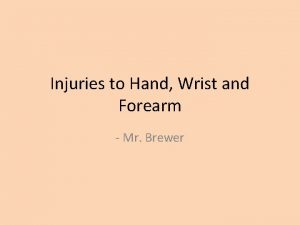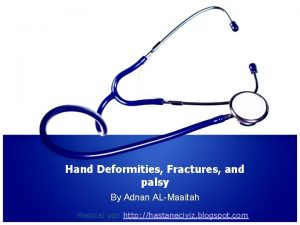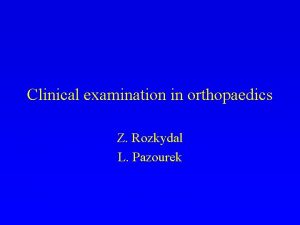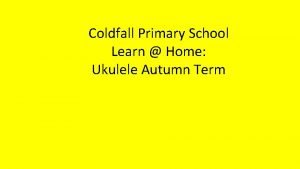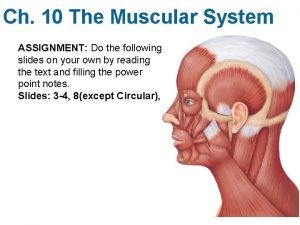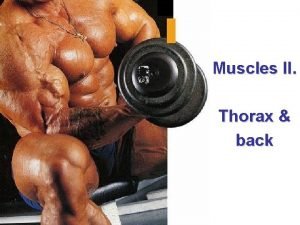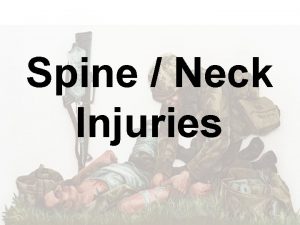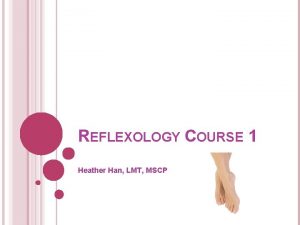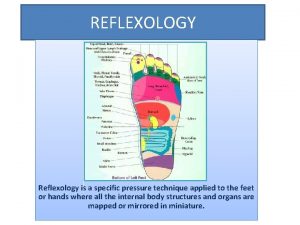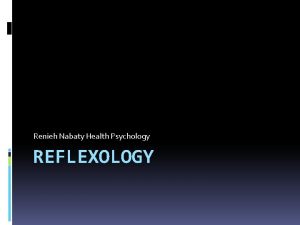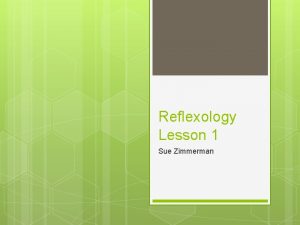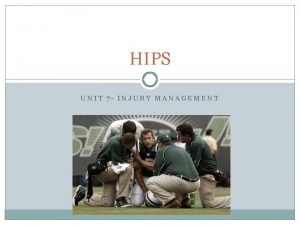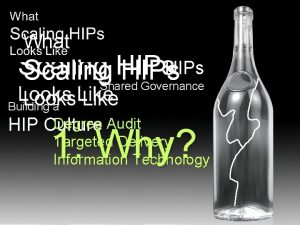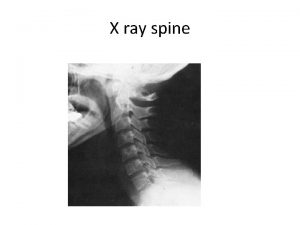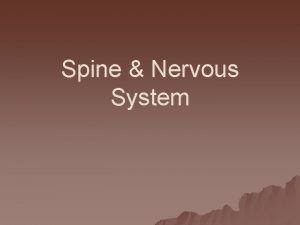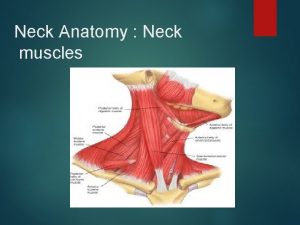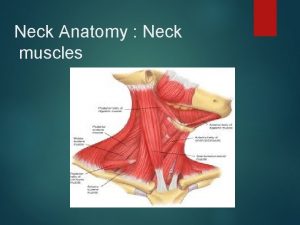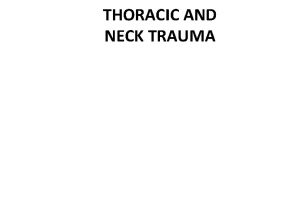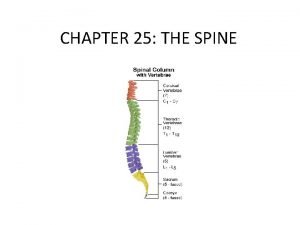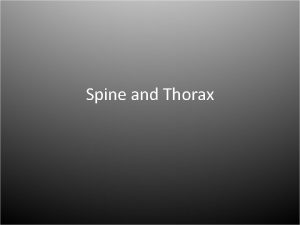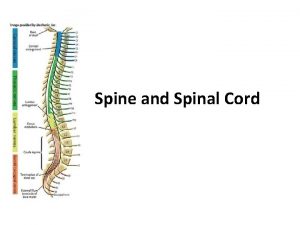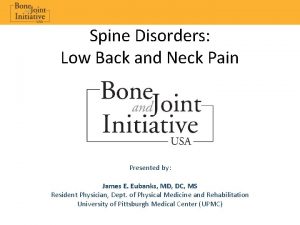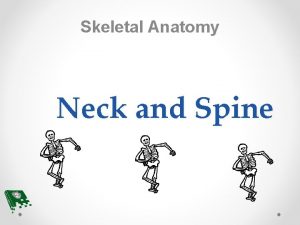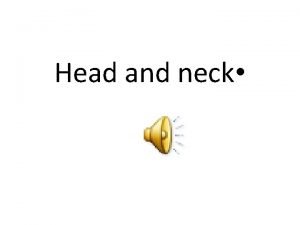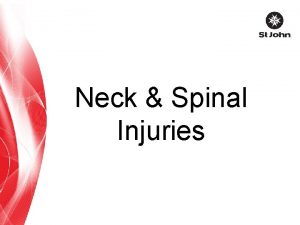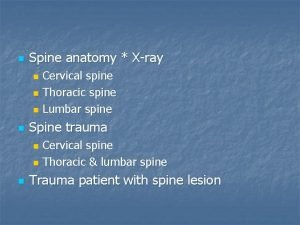REFLEXOLOGY TIPS FOR THE NECK SPINE HIPS AND















































- Slides: 47

REFLEXOLOGY TIPS FOR THE NECK, SPINE, HIPS, AND SHOULDERS Heather Han, LMT, MSCP

COURSE DESCRIPTION Students completing this course will be able to understand the basic theory of reflexology, guidelines on the feet, joint mobilization techniques for the feet, and the locations of the corresponding reflex points on the feet for the neck, spine hips and shoulders.

WHAT IS REFLEXOLOGY? A manual therapy focusing on reflex points of the hands, ears and feet that affects the whole body. HOW DOES REFLEXOLOGY WORK? Pressure on the feet and hands affects all organs glands and parts of the body. The main effects are bringing the body to balance or homeostasis, relaxation, and circulation. Reflexology improves circulation of blood and energy and stimulates the parasympathetic nervous system

FEET, HANDS AND EARS AS MAP OF THE BODY

FEET, HANDS AND EARS AS MAP OF THE BODY

IDENTIFY LANDMARKS OF THE FEET Base of toes- neck line Diaphragm – below ball of foot Waist- base of fifth metatarsal Heel-pelvic line Spine 5 zones on each foot

50 - POINT CHART







ZONE THERAPY Zone therapy- what happens in one part of Zone it can affect any organ or gland in that Zone, viewed as simplified meridian system

FOOT RELAXATION Ankle range of motion – dorsiflexion, plantarflexion Ankle rotation- hand on dorsal, hand on heel Foot side to side shake Ankle side to side shake Toe side to side shake toe rotation Spinal Twist (medial) Metatarsal press (plantar) Metatarsal roll Foot pinching (lateral) Diaphragm tension relaxer

TECHNIQUES Thumbwalking- most areas, primarily plantar surface of the foot Rotate

REFLEXOLOGY ON THE SPINE Spine- medial aspect of foot � Cervical- base of big toenail to below joint � Thoracic- below joint to waist � Lumbar- waist to heel � Sacrum- below heel � Coccyx- middle heel


REFLEXOLOGY ON THE NECK

REFLEXOLOGY ON THE SHOULDERS

REFLEXOLOGY ON THE HIP


EUNICE INGHAM AND DWIGHT BYERS

TECHNIQUES Thumbwalking- most areas, primarily plantar surface of the foot It inches forward not backward or side to side Constant pressure applied with lateral edge of the thumb Thumb remains slightly bent while moving forward Support foot with holding hand

GUIDELINES FOR TREATMENT Wash hands, trim nails, watch posture, relax, breath, stay grounded Take medical history For client – no stimulants, depressants or heavy meals before session Medication alcohol or drugs may reduce sensitivity More relaxation and less pressure for first session For sore areas go to pain threshold, work other areas and come back, work from different directions Answer questions in general terms Encourage rest after the session

TECHNIQUES Thumbwalking- most areas, primarily plantar surface of the foot Finger roll- brain- distal toe- applied with pad of index finger Finger walk- dorsal foot, applied with lateral edge of index finger Hook in and pull back- pituitary, ileocecal valve, sigmoid flexure- applied with lateral edge of thumb, sinking in and hooking slightly Rotate- spine, diaphragm, lymph drain

REFLEX POINT LOCATIONS 1 -14 1. Spine- medial aspect of foot 1. 2. 3. 4. 5. 2. 3. 4. Cervical- base of big toenail to below joint Thoracic- below joint to waist Lumbar- waist to heel Sacrum- below heel Coccyx- middle heel Brain- distal 1/3 of toes Sinuses- middle 1/3 of toes Temple- distal 3 rd of big toes lateral

REFLEX POINT LOCATIONS 1 -14 5. 6. 7. 8. 9. 10. 11. 12. 13. 14. Side of the neck- proximal 2/3 of big toe lateral Eye, inner ear- neck zones 2 -3 Middle outer ear- neck zones 4 -5 Nose – middle 3 rd of toes Mouth- proximal 3 rd of toes Throat- neck Jaw- proximal 2/3 of toe, tmj little toe Teeth gums- proximal 3 rd of toes Pituitary pineal- lateral center of big toes- peak Thyroid parathyroids- neck

WHY WORK THE FEET? In use everyday for going places and daily tasks Often neglected Good substitute for massage when there are contraindications in other parts of the body Accumulation of tension and debris from gravity Anatomical relationship between feet and body simple and easy to understand

EXPLORING THE FEET It is important to careful inspect the feet and notice foot conditions Temperature of different areas Texture (soft and hard areas) Bones Muscles Tendons Foot Oder Cracking in Tissues Flexibility and mobility Redness puffiness or swelling Corns, calluses, cuts, bruises, rashes, etc

WHAT GRANULAR DEPOSITS MAY BE When you feel areas of tension or deposits releasing them can improve circulation. Often these places are called “crystals” or “crunchies” by reflexologists. Here are some of the causes of these irregularities in the feet. Solid acid build up such as lactic or uric acid due to trauma, overuse, poor nutrition, lack of oxygen, poor circulation Injured, hardened or inflamed nerve endings Tension or energy blocks Tissue degeneration, adhesions or scabs Pollutants, foreign particles, metallic or fatty accumulations and build up Calcifications such as bone spurs

REFLEX POINT LOCATIONS 1 -14 1. Spine- medial aspect of foot 1. 2. 3. 4. 5. 2. 3. 4. Cervical- base of big toenail to below joint Thoracic- below joint to waist Lumbar- waist to heel Sacrum- below heel Coccyx- middle heel Brain- distal 1/3 of toes Sinuses- middle 1/3 of toes Temple- distal 3 rd of big toes lateral

REFLEX POINT LOCATIONS 1 -14 5. 6. 7. 8. 9. 10. 11. 12. 13. 14. Side of the neck- proximal 2/3 of big toe lateral Eye, inner ear- neck zones 2 -3 Middle outer ear- neck zones 4 -5 Nose – middle 3 rd of toes Mouth- proximal 3 rd of toes Throat- neck Jaw- proximal 2/3 of toe, tmj little toe Teeth gums- proximal 3 rd of toes Pituitary pineal- lateral center of big toes- peak Thyroid parathyroids- neck

WHO REFLEXOLOGY HELPS Elderly Children Pregnant women Overweight Athletes People who are often on their feet People with foot problems People under a lot of stress Bedridden people

WHAT CLIENTS MAY EXPERIENCE Deep relaxation Balance, centered, mentally clear Revitalization Light floaty feeling- endorphin release Tingling or itchiness form improvement in nerve flow Healing signs from toxin release- nausea, diarrhea, sinus drainage, emotional release

TECHNIQUES Thumbwalking- most areas, primarily plantar surface of the foot Finger roll- brain- distal toe- applied with pad of index finger Finger walk- dorsal foot, applied with lateral edge of index finger Hook in and pull back- pituitary, ileocecal valve, sigmoid flexure- applied with lateral edge of thumb, sinking in and hooking slightly Rotate- spine, diaphragm, lymph drain

REFLEXES 15 -31 15. 16. 17. 18. 19. 20. 21. 22. 23. Esophagus- diaphragm to neckline, medial zone 1 left Diaphram- diaphragm line zones 1 -5 Solar Plexus- proximal to diaphragm, zone 2 Lung- Diaphram to neckline, zone 2 -5 right, zones 1 -2 left Heart- diaphragm to neckline, zone 1 right, zones 1 -2 left Thymus- diaphragm to neckline, medial zone 1 Bronchial tube- diaphragm to neckline, between zones 1 -2 Shoulder- Diaphragm to neckline, zone 5, between zones 45 Lymph Drain- Dorsal Metatarsals between zones 1 -2, dorsal ankle

REFLEXES 15 -31 24. 25. 26. 27. 28. 29. 30. 31. 24. Ribs/ upper back- Diaphragm to neckline between metatarsals down to waistline 25. Breast- diaphragm to neckline, between zones 3 -4 26. Liver- Waistline to diaphragm, zones -4 right, zone 1 left 27. Gall bladder- halfway between waistline and diaphragm, zone 4 right 28. Adrenal- waistline 1/3 to diaphragm, zones 1 left, zone 1 right 29. Stomach- waistline to diaphragm, zones 1 -4 left, zone 1 right 30. Spleen- proximal to diaphragm, between zones 4 -5, left 31. Pancreas- waistline halfway to diaphragm, zones 1 -4 left, waistline

REFERRAL AREAS Upper back/lower back Fingers/ toes Shoulder/ hip Upper arms/ Thigh Elbow/knee Forearm/leg Wrist/ankle Hands/foot Thumbs/ big toe

PRIMARY AND HELPER AREAS Primary/ direct – specific condition Secondary/ helper- aid and reinforce healing

REFLEXES 15 -31 15. 16. 17. 18. 19. 20. 21. 22. 23. Esophagus- diaphragm to neckline, medial zone 1 left Diaphram- diaphragm line zones 1 -5 Solar Plexus- proximal to diaphragm, zone 2 Lung- Diaphram to neckline, zone 2 -5 right, zones 1 -2 left Heart- diaphragm to neckline, zone 1 right, zones 1 -2 left Thymus- diaphragm to neckline, medial zone 1 Bronchial tube- diaphragm to neckline, between zones 1 -2 Shoulder- Diaphragm to neckline, zone 5, between zones 45 Lymph Drain- Dorsal Metatarsals between zones 1 -2, dorsal ankle

REFLEXES 15 -31 24. 25. 26. 27. 28. 29. 30. 31. 24. Ribs/ upper back- Diaphragm to neckline between metatarsals down to waistline 25. Breast- diaphragm to neckline, between zones 3 -4 26. Liver- Waistline to diaphragm, zones -4 right, zone 1 left 27. Gall bladder- halfway between waistline and diaphragm, zone 4 right 28. Adrenal- waistline 1/3 to diaphragm, zones 1 left, zone 1 right 29. Stomach- waistline to diaphragm, zones 1 -4 left, zone 1 right 30. Spleen- proximal to diaphragm, between zones 4 -5, left 31. Pancreas- waistline halfway to diaphragm, zones 1 -4 left, waistline

PROFESSIONAL ETHICS Training Public safety Standards of practice Consult medical professional Self –care ( review code of ethics)

REFLEXOLOGY REFERRAL AREAS FOR SPECIFIC CONDITIONS Reminder: “Do not diagnose, prescribe or claim to treat specific conditions” Constipation- liver, gallbladder, diaphragm, adrenals, lower spine, sigmoid, illeocecal Diarrhea- ascending colon, transverse colon, diaphragm, liver, adrenals Insomnia- diaphragm, call glands Edema- lymph system, kidneys, adrenals Tinnitus- ear reflex, cervical, neck , great toe Headache- whole spine, diaphragm, all glands, toes Cramps- hip/knee, sciatic, lower spine, parathyroid, adrenals Sprain- specific area, referral area

REFLEXOLOGY POINTS 32 - 50 32. 33. 34. 35. 36. 37. 38. 39. 40. Illeocecal Valve- medial of cuboid notch between zones 4 -5 right Ascending colon- heel line to waistline, between zones 4 -5 right Hepatic Flexure- waistline, zone 4 right Transverse colon- waistline, zones 1 -4 Splenic Flexure- waistline, zone 4 left Descending Colon- waistline to heel line, between zones 4 -5, left Sigmoid colon- mid heel, between zones 3 -4, left Small Intestines- heel line to waistline, zones 1 -4 Kidney- above, on and below waistline, medial tendon

REFLEXOLOGY POINTS 32 - 50 41. 42. 43. 44. 45. 46. 47. 48. 49. 50. Ureter tube- heel line to waistline, medial tendon Bladder/ Sacroilliac joint- heel line, medial Sciatic – lower heel, zones 1 -5 Uterus/Prostate- halfway between heel and ankle, medial Ovary /teste- halfway between heel and ankle, lateral Fallopian Tube/ lymph Drain- dorsal ankle Chronic area- medial aspect of leg, spleen 6 point to medial heel Arm/hand- waistline to diaphragm line lateral Hip/ Knee /Leg- cuboid notch triangle, lateral Hip / Sciatic- posterior to lateral anklebone

TECHNIQUES Thumbwalking- most areas, primarily plantar surface of the foot Finger roll- brain- distal toe Finger walk- dorsal foot Hook in and pull back- pituitary, ileocecal valve, sigmoid flexure Rotate- spine, diaphragm, lymph drain
 Spinal reflexology
Spinal reflexology Chapter 26 pedicuring review questions
Chapter 26 pedicuring review questions Parts of pants
Parts of pants The history of reflexology
The history of reflexology Reflexology for cancer
Reflexology for cancer Reflexology for breast cancer
Reflexology for breast cancer Oncology massage alliance
Oncology massage alliance Hops assessment
Hops assessment Hands up utensils down
Hands up utensils down Wide hips body type
Wide hips body type Ectomorph sports persons
Ectomorph sports persons Hops notes athletic training
Hops notes athletic training Hops procedure
Hops procedure Rhythm has your two hips moving
Rhythm has your two hips moving Hips dipa
Hips dipa Galeazzi sign
Galeazzi sign Ddh définition
Ddh définition Gluteal fold
Gluteal fold Hip to waist ratio
Hip to waist ratio Lan network design
Lan network design Is hips a thermosetting plastic
Is hips a thermosetting plastic A short backboard or vest-style immobilization
A short backboard or vest-style immobilization Chapter 21 caring for head and spine injuries
Chapter 21 caring for head and spine injuries Lumbar referral patterns
Lumbar referral patterns Macro current in electrotherapy
Macro current in electrotherapy Who is in charge when spine boarding an athlete and why
Who is in charge when spine boarding an athlete and why Sentinel injuries in infants are
Sentinel injuries in infants are My ukulele has a body a neck and a head
My ukulele has a body a neck and a head Tnm 8 head and neck
Tnm 8 head and neck Rash on upper chest and neck
Rash on upper chest and neck Muscles of facial expression
Muscles of facial expression Temporalis
Temporalis Anatomy of the throat and neck
Anatomy of the throat and neck What type of bird does the tinikling dance imitates?
What type of bird does the tinikling dance imitates? Interrosei
Interrosei Boutonniere and swan neck deformity
Boutonniere and swan neck deformity Scapulohumeral rhythm
Scapulohumeral rhythm Boutonniere and swan neck deformity
Boutonniere and swan neck deformity Rheumatoid nodules
Rheumatoid nodules Boutonniere and swan neck deformity
Boutonniere and swan neck deformity Swan neck deformity
Swan neck deformity Boutonniere and swan neck deformity
Boutonniere and swan neck deformity Waiter's tip deformity
Waiter's tip deformity Objective examination of patient
Objective examination of patient Risk factors of head and neck cancer
Risk factors of head and neck cancer There once was a man from tennessee ukulele
There once was a man from tennessee ukulele Muscular system head and neck
Muscular system head and neck Trigonum petit
Trigonum petit
